
At the Aero show in Friedrichshafen, in 2012, the undisputed star was a sleek and sexy four-place single from the innovative Slovenian company, Pipistrel. The Panthera surprised on several levels because Pipistrel was a player in the world of microlight/light sport aircraft, but wasn’t thought to harbor aspirations toward the mainstream certified market.
But a year later, the Panthera flew and a year after that in 2014, I flew a prototype off the company’s grass runway at Ajdovscina, Slovenia. Pipistrel promised that certification was proceeding apace, but the project was soon pushed to the back of the stove. Now it has re-emerged with some 20 airframes flying and with the first U.S. example popping up in Florida in late summer 2020. What Pipistrel has in mind is selling a few experimental versions of the airplane—not kits, but factory-built airframes for the experimental/exhibition category—followed by certified versions sometime in 2022. Sticker for the experimental version is about $639,000, versus $672,000 for the certified airplane.
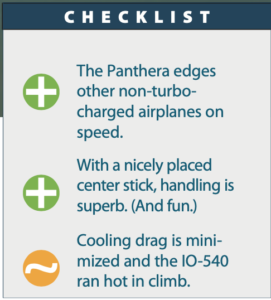
The Panthera promised a 200-knot airplane that would be more efficient than anything else and greener too, since it would eventually be offered in both pure electric and hybrid-electric versions. What it has, at least for now, is a not-quite-200-knot airplane with efficiency a little north of modern Mooneys, an adequate albeit not capacious cabin and sporty, well-harmonized handling. Where it fits in a market dominated by Cirrus, or even if it fits, is difficult to predict.
Founded by Ivo Boscarol in 1989 in the waning days of Slovenia’s existence as a Yugoslavian state, Pipistrel hasn’t drifted from a devotion to efficient, environmentally friendly flying machines. True to Boscarol’s unswerving vision, Pipistrel is actually building and selling electric airplanes and just certified the first electric trainer, the Velis Electro.
As a four-place, high-speed cruiser, the Panthera leaps over the modest trainers that most companies have developed in a logical progression. Think of Cessna jumping straight from the 150 to the 210, or even the TTx.
BACK ON TRACK
The Panthera didn’t so much run off the rails as get sidetracked. “The main reason it was held up was because Pipistrel was contracted by several governments, including the U.S. government, to convert their two-seat airplanes into unmanned aerial systems for surveillance use by the military,” says Andy Chan of Right Rudder Aviation. The Inverness, Florida-based Right Rudder will be the U.S. distributor for the Panthera and is now investing in marketing and support for the airplane.
Significantly, Pipistrel’s expertise in building light, low-drag airframes gives it an advantage in converting them to surveillance platforms. Diamond has done the same, but only Pipistrel has succeeded in repurposing an airframe originally designed for a combustion engine to electric propulsion.
The electric Panthera may or may not happen, but the current gasoline version has more ponies than the original Panthera prototype had. Pipistrel originally proposed the 210-HP Lycoming IO-390 because its power-to-weight ratio fit the airplane and it could burn autogas. Except it couldn’t. As engine certification closed, Lycoming revealed that the IO-390’s 8.9-to-1 compression ratio lacked detonation margins for autogas use, so early in the project Pipistrel switched to the 260-HP IO-540-A5V4, which does allow autogas fueling, or, specifically AKI 93 meeting the ASTM D4814/EN228 specification.
For an additional 50 horsepower, the IO-540 weighs about 100 pounds more or so and it’s longer. Pipistrel was able to rejigger the mount design and center of gravity to accommodate the engine by adding some additional length to the airframe. The engine swap was probably fortuitous. Low-drag airframe or not, the IO-390 version was an unlikely 200-knot airplane, based on what I saw in 2014. Moreover, without turbocharging, the IO-390 wouldn’t have had much grunt in high density altitude conditions, a requirement topping Pipistrel’s must-have list.
THE SPECS
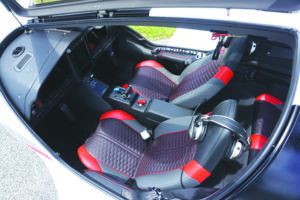
So what the Panthera is now is a 2900-pound, low-slung, sleek airframe with a useful load hovering around 1100 to 1200 pounds. That puts it in league with modern Mooneys and the Columbia/Cessna aircraft, but 240 pounds less than recent Cirrus models and about 130 pounds less than the just-certified Diamond DA50. Dimensionally, the Panthera is the smallest of this lot. It’s the same length as the Cirrus SR22, but, at 35 ft. 8 in., the wingspan is almost three feet less. Even with the tall T-tail, the Panthera is nearly a foot shorter than the Cirrus.
As would be expected, the Pipistrel is narrower than the SR22—I measured the interior at 47 inches—compared to 49 inches for the Cirrus. Once seated inside, I didn’t find it snug, exactly, but it’s not as spacious as the SR22.
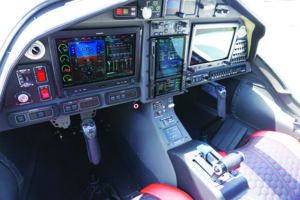
The Panthera was intended as a fully composite airplane, specifically carbon fiber, which offers superior strength to weight over fiberglass. The company says the cabin is constructed as a rigid shell designed to provide occupant crash protection in a roll-cage structure. Because carbon fiber is susceptible to sharding during impact, the occupant spaces are protected with Kevlar.
The cabin is accessed via two large gullwing doors and, for the rear occupants, an even larger gullwing hatch similar to Diamond’s approach on the DA40/42/62 series.
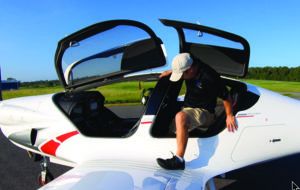
Gullwing doors are a compromise. While they provide ready access, they also inhibit or entirely prevent emergency egress if the airplane flips over in a crash. We’ve complained about this for years. Yet, review of hundreds of accident reports reveals that occupants being trapped after a crash doesn’t appear to be a real-world problem. Either airplanes don’t flip much or, if they do, survivors egress successfully. The Panthera’s rear hatch is supposed to be an emergency egress point and a glass cutting hammer is provided.
Opening in flight is another concern, because the door is likely to depart the airframe and could strike and damage the tail. Pipistrel seems to have addressed this with a robust closing mechanism with steel pins inserted into the door frame. The rotating mechanism feels like it snaps solidly over center to lock securely. Only time in service will reveal if this design is foolproof much less idiot proof. When ingressing/egressing in rain, the interior is going to get moist, along with the occupants.
Unlike the Cirrus with its long single-piece wing, the Panthera has two wings and the stub wings on the fuselage give it a width that just fits inside a standard shipping container. The wings mount on shipping brackets so the whole shebang comes in one box. The wings have a pair of spars that fit together in the fuselage with a pin assembly. Control circuitry is push rods for ailerons and elevator, cable for rudders.
The wing flaps are about two-thirds span with one interesting detail: The flap section over the wing walk area on both sides is protected with a solid surface so there’s no chance of stepping on the flap. Technically, that makes that section split rather than Fowler flaps. The flaps are electric, controlled by a two-position switch and the gear is similarly electric through a transmission with rods and tubes. The backup gear system is a crank located in the center console between the two front seats.
Chan told me he doesn’t consider the fuel tanks wet wings, but they aren’t removable cells, either. The sealed areas are protected with an alcohol-resistant coating in the event ethanol-laced fuel finds its way into the tanks. (Up to 2 percent is allowed.)
Two tank versions will be available, one with two main tanks totaling 55 gallons and a second with two aux tanks bringing the total to 91 gallons. The 91-gallon version will offer a 100-pound gross weight increase to an even 3000 pounds. One thing I don’t like is that the airplane will have transfer pumps to move fuel from the aux to the mains. Given that pilots manage to bollix up left-right-off fuel systems, adding transfer pumps just complicates things. The system will have overflow protection to prevent pumping overboard if the mains don’t have ullage for the transfer.

These two charts show how the Panthera ranks relative to other high-performance single-engine aircraft of the same class. It just edges out the Mooney Ovation and Diamond DA50 RG, a newly certified model, for speed.
It’s even a bit faster than the Cirrus SR22T if the latter is flown at 18,000 feet. Take the Cirrus higher and it will outrun the Panthera. The Mooney Acclaim retains its title as class leader in speed.
Specific range is a measure of how far in nautical miles an airplane flies on a pound of fuel. The fact that the Panthera beats out both Mooney models is a measure of how effectively Pipistrel has reduced airframe drag. With its turbocharged diesel, the Diamond DA50 RG is the efficiency leader at the expense of a little speed. We’re relying on Diamond’s marketing information for the calculation here. We haven’t seen the POH or flown the airplane.
AVIONICS
Pipistrel will offer a two-display version of Garmin’s G3X Touch, plus a GTN 650/750 combination with autopilot. While this provides sufficient capability, some buyers may view it as a step down from the G1000 NXi found in new Cirrus and Diamond models. Because of the smaller panel space, it’s not clear that the NXi would fit and, in any case, it would be more expensive.
On the plus side, the G3X is easier to use without giving up much capability. With the two GTNs, there’s more than enough panel space for maps, engine displays and the primary flight display. The displays themselves don’t have backup batteries, but the airplane has a secondary battery to power an essential bus that includes the primary flight display and one of the two ADAHRS units. Additional backup is provided by a Mid-Continent SAM MD302, plus the Touch display has reversionary capability for primary attitude. For a piston airplane, the Panthera has more than enough backup. It also has a GRS whole-airframe parachute that’s standard but not required as a condition of certification as in the Cirrus.
The version I flew did not have Garmin’s ESP envelope protection, although that is available for the autopilot and is a planned addition. And while I can envision versions of the NXi/GFC 700 in the Cirrus and perhaps Diamond aircraft eventually getting Garmin’s Autoland option, it’s not contemplated for the Panthera, nor are there any other avionics options. ADS-B is the remote GTX 345 transponder.
Two options that are contemplated are air conditioning and icing protection of some kind. The weights of these additions are unknown, but if they prove to be similar to the Mooney numbers, the choice might be one or the other, but not both. TKS panels also exact a slight speed penalty.
The Panthera has a clever display idea in an LCD sub-panel forward of the throttle that, in default, shows cabin air status. Push the test button under the gear switch, and it reverts to status of gear, flaps and fuel state in percentage. Nice piece of design.
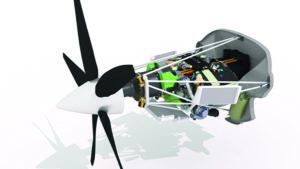
Maybe. Maybe not. Pipistrel is unquestionably the leading company producing and selling electric airplanes. But it’s also been involved in broader aviation electric propulsion projects meant to be milestones on the way to larger aircraft.
One of these is a consortium project called MAHEPA for Modular Approach to Hybrid Electric Propulsion Architecture. Funded by the EU, MAHEPA consists of eight companies and universities whose goal is a modular and scalable system for hybrid-based electric aircraft.
During the years I’ve been covering Pipistrel, I’ve noticed a slow but discernible realization that batteries aren’t going to be the golden path to electric flight for the near future and perhaps ever.
A hybrid Panthera cycle could work like this: The airplane has sufficient battery energy to take off and climb, the advantages being lower noise and better density-altitude performance. Enroute, the hybrid system—a combustion engine driving a generator— would recharge the batteries and provide cruise power.
This is actually the second such investigation. A previous project called HYPSTAIR developed hardware that was installed in a prototype Panthera. Using a Rotax engine, the project completed ground runs but never flew.
Pipistrel’s Tine Tomazic told me in September that MAHEPA will produce a flyable airplane. But that’s not the same as a marketable airplane. “The hybrid will fly as a prototype under a research program later this year, but we have not yet commissioned to build an all-electric Panthera version. We’re still in anticipation of breakthrough battery technology,” he said.
FLYING IT
In boarding the Panthera for flight, there are two immediate “oh dear” moments. The first is cockpit ingress. You mean I have to put my sneaker on that beautiful leather seat? Actually, no, but acquired muscle memory is needed. You can step right on to the cockpit floor inboard of the stick then use a handgrip in the glareshield to lever yourself into the seat. It’s easy the second or third time you try it. But getting out will be a challenge for people who are large or, to be blunt, unfit. The glareshield grips helps, but some prying and lifting on the cockpit wall may be necessary.
The second problem is the view forward. There isn’t much. The small, low-drag frontal area was achieved by having the occupants somewhat reclined and deep inside the cabin vertically. The glareshield is quite high, like the original long-body Mooneys before the glareshields were lowered almost two inches because of pilot complaints.
Further, although there’s no A-pillar, there’s a sloping center column that partially obscures the forward view. This means you can’t see far beyond the right side of the nose when taxiing and I noticed when turning into the downwind from crosswind in the pattern, I wouldn’t necessarily be able to see traffic entering the downwind without lowering the nose a little. This limitation will require accommodation and, in my view, some would-be buyers might not be willing to make it.
I flew the Panthera on a typical steamy Florida day in late August made for air conditioning. This is where the gullwing doors and seating position are a plus. You can taxi with doors full open propped by their gas springs or held partially open and I found this provided more than enough cooling blast direct from the prop. In the pattern, we noticed a warmish flow of air from the eyeball vents in the panel. Andy Chan thought this might be due to the electronically controlled heater valve not closing completely. Whatever the case, it will need to be addressed; at low altitude, with all that glass, the cabin was just too hot, even for me.
In my view, the Cirrus and Columbia/Cessna airplanes are nice flying airframes, but the designs coming from Europe—Diamond and now the Panthera—are just nicer. For one thing, they have center sticks, which provide a more precise, uncompromised feedback feel from the control surfaces. Sidesticks or controllers, in my view, require less natural muscle movements, no matter how we’ll designed, with the possible exception of the Airbus.
This is noticeable immediately on takeoff roll in the Panthera. Thanks to a steerable nosewheel, it feels surgically precise when taxiing and on takeoff, the tug required for rotation is just right with no tendency to over rotate. It breaks loose at about 65 knots with moderate but not over light pitch force. On the roll and during initial climb, the restricted forward visibility wasn’t noticeable and I had no problem forming a climb sight picture in a straight climb.
FAST CLIMBER
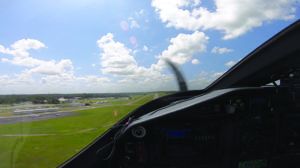
The Panthera is a strong climber. I saw at least 1600 FPM initially, but climb cooling may be an issue. Above 2000 feet, the CHTs were all hotter than 400 degrees so Chan recommended 130 knots, which still yielded 600 to 800 feet of climb rate. As you can see from the photos, the IO-540 is tightly cowled with small inlets directing air into a sculpted plenum.
I doubt if there’s much reserve cooling. If the temperatures can be kept in line, the Panthera should meet Pipistrel’s requirement for high density altitude performance, but some tweaking may be needed.
I’d call the Panthera’s handling fighter like, but the only fighter I’ve flown is the P-51 and the Panthera is way better in ease of control and lack of bad habits. However, its stall isn’t as benign as say a Diamond DA40. It takes effort to provoke a burble, but if held into the stall, it will break noticeably. It doesn’t seem to have a parachute mode. Indicative of its low drag, if the pitch is displaced nose high, the airplane takes its time damping the phugoid and reached just shy of Vne before starting uphill again.
Pipistrel decided not to equip the airplane with speedbrakes and that’s probably a good decision. But it does take planning to get the airplane slowed to the relatively low 106-knot Vlo. (The Mooney Ovation, by comparison, is 140 knots.) Vfe is the same 106 knots.
The airplane is a hoot in the pattern. It doesn’t require a lot of fussy trimming and sticks to the trimmed speed like glue. My approaches were too fast by at least 5 knots and the touchdowns may have been too fast, too. (Seventy-five knots is recommended for approach.)
It has trailing link mains so even touching down fast, the airplane plants with no bounce. With a few more hours, I felt I could slow the approach to under 70 knots for shorter rollouts. My draft POH lacked takeoff and landing data and although the Panthera will never be a STOL airplane, a proficient pilot shouldn’t fear a 2500-foot runway, at least at light weights.
The POH did have numbers for cruise and even on an ISA +30 day, the Panthera hit them. I took it to 6000 and 8000 feet and once the airplane settled down, it delivered 184 knots true on 13 GPH at 65 percent power. At 55 percent, it cruised at 174 knots on about a gallon less. Also, the CHTs cooled below 400 degrees F, but I wouldn’t mind seeing cooler than that.
With the aux tank option, those numbers translate to still-air range of 1100 miles and nearly 1200 miles, respectively, with three, not four, seats filled. Occupy all the seats and the range is just shy of 1000 still-air miles, assuming the current weight numbers hold.
And weight wise, the Panthera has about 1100 pounds of useful load. The CG envelope is a generous 9 inches, so loading it out of limits will take deliberate effort. With two heavy people in the back and 100 pounds of bags, my sample problem put the airplane 50 pounds over gross but easily within CG.
CONCLUSION
With the airplane still uncertified and the POH in draft form, it’s too soon to judge the Panthera as a finished product. The road to final certification often has surprises. That said, so far, so good. Marketwise, I’m not sure where the Panthera fits, but I doubt it’s a direct competitor to the Cirrus line.
Cirrus owners fly their kids to look at colleges, but I’m gonna guess the would-be Panthera buyer would apologize to the kids for spending their college fund on a new airplane, which is to say it might be the passion-driven choice. If you like sporty handling, efficient performance and turning heads on the ramp, the Panthera is your airplane.
To summarize it, the Panthera carries a little more than a Mooney, but less than a Cirrus and it’s a little faster than both, including the SR22T at lower altitudes. As the specific range calcs show, it’s more efficient than either, at the expense of a less spacious cabin compared to the Cirrus.
Functionally, its avionics are adequate to the task, but not as sophisticated as the top-of-the-line G1000. The ballistic parachute has proven a sales plus for the Cirrus and that may also be true for the Panthera. Other than Cirrus, no other manufacturer has offered a high-performance single with a parachute.
Where the Panthera really stands out, in my view, is pure flyability. With its center stick and well-balanced control forces, some buyers might be attracted just on that count alone. If you tilt toward an Audi R8 over a Q5, the Panthera might be your pick.
Watch the Panthera video report at http://tinyurl.com/j95ht2a.

